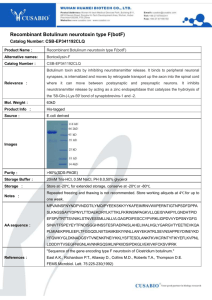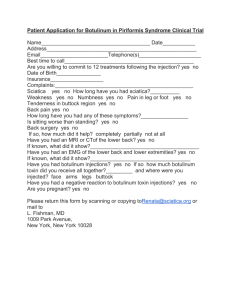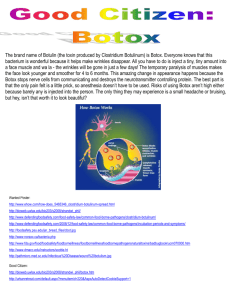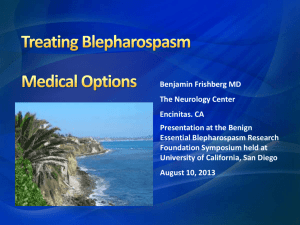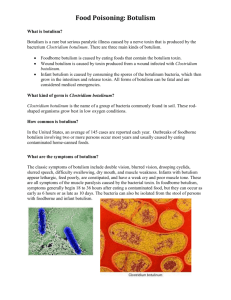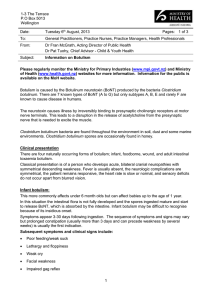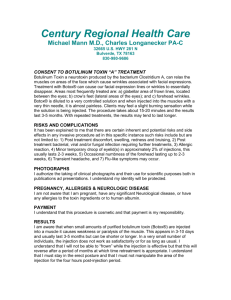PDF, 250 KB
advertisement
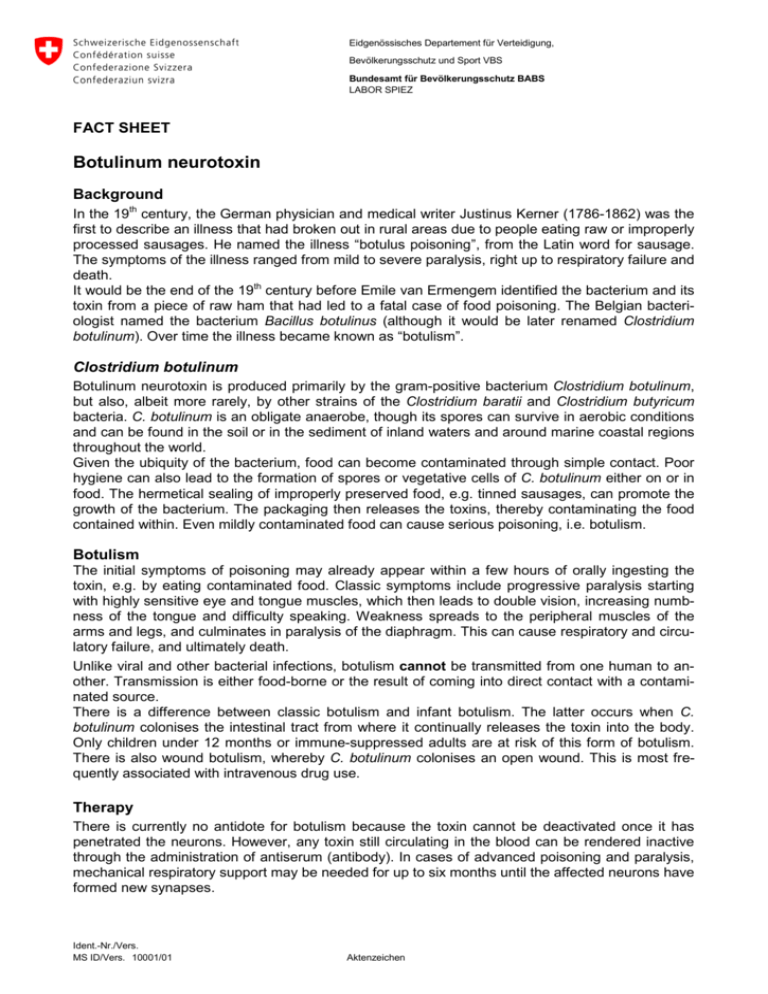
Eidgenössisches Departement für Verteidigung, Bevölkerungsschutz und Sport VBS Bundesamt für Bevölkerungsschutz BABS LABOR SPIEZ FACT SHEET Botulinum neurotoxin Background In the 19th century, the German physician and medical writer Justinus Kerner (1786-1862) was the first to describe an illness that had broken out in rural areas due to people eating raw or improperly processed sausages. He named the illness “botulus poisoning”, from the Latin word for sausage. The symptoms of the illness ranged from mild to severe paralysis, right up to respiratory failure and death. It would be the end of the 19th century before Emile van Ermengem identified the bacterium and its toxin from a piece of raw ham that had led to a fatal case of food poisoning. The Belgian bacteriologist named the bacterium Bacillus botulinus (although it would be later renamed Clostridium botulinum). Over time the illness became known as “botulism”. Clostridium botulinum Botulinum neurotoxin is produced primarily by the gram-positive bacterium Clostridium botulinum, but also, albeit more rarely, by other strains of the Clostridium baratii and Clostridium butyricum bacteria. C. botulinum is an obligate anaerobe, though its spores can survive in aerobic conditions and can be found in the soil or in the sediment of inland waters and around marine coastal regions throughout the world. Given the ubiquity of the bacterium, food can become contaminated through simple contact. Poor hygiene can also lead to the formation of spores or vegetative cells of C. botulinum either on or in food. The hermetical sealing of improperly preserved food, e.g. tinned sausages, can promote the growth of the bacterium. The packaging then releases the toxins, thereby contaminating the food contained within. Even mildly contaminated food can cause serious poisoning, i.e. botulism. Botulism The initial symptoms of poisoning may already appear within a few hours of orally ingesting the toxin, e.g. by eating contaminated food. Classic symptoms include progressive paralysis starting with highly sensitive eye and tongue muscles, which then leads to double vision, increasing numbness of the tongue and difficulty speaking. Weakness spreads to the peripheral muscles of the arms and legs, and culminates in paralysis of the diaphragm. This can cause respiratory and circulatory failure, and ultimately death. Unlike viral and other bacterial infections, botulism cannot be transmitted from one human to another. Transmission is either food-borne or the result of coming into direct contact with a contaminated source. There is a difference between classic botulism and infant botulism. The latter occurs when C. botulinum colonises the intestinal tract from where it continually releases the toxin into the body. Only children under 12 months or immune-suppressed adults are at risk of this form of botulism. There is also wound botulism, whereby C. botulinum colonises an open wound. This is most frequently associated with intravenous drug use. Therapy There is currently no antidote for botulism because the toxin cannot be deactivated once it has penetrated the neurons. However, any toxin still circulating in the blood can be rendered inactive through the administration of antiserum (antibody). In cases of advanced poisoning and paralysis, mechanical respiratory support may be needed for up to six months until the affected neurons have formed new synapses. Ident.-Nr./Vers. MS ID/Vers. 10001/01 Aktenzeichen In the past, laboratory personnel who worked with Botulinum neurotoxin were vaccinated with the inactivated toxin. Today, however, this practice is not recommended in the interests of preventing resistance to any later clinical treatments that involve use of the toxin. Composition/structure Botulinum neurotoxin is a proteinogenic toxin. All C. botulinum neurotoxins are synthesised as a single polypeptide chain. Once in the cytoplasm it cleaves into two separate chains, the heavy chain (HC) with a molecular weight of around 100k Da and the light chain (LC) of around 50 kDa. A disulfide bridge (Figure 1). The heavy chain has two domains. In one domain the neurotoxin bonds specifically to the motor end plate of the cholinergic neuron, while in the other it is translocated to the inside of the cell. The light chain is a zinc-bound endoproteinase. It specifically cleaves the SNARE proteins of the motor end plate of the neuron, thereby suppressing the transmission of nerve impulses to the muscle. HEAVY CHAIN Translocation LIGHT CHAIN Effector (Endopeptidase) Receptor binding = Zn2+ S-S = disulfid bridge 2/4 Ident.-Nr./Vers. Aktenzeichen taining the neurotransmitter acetylcholine fusing with the plasma membrane of the motor end plate. This blocks the release of neurotransmitters in the synaptic cleft, thereby halting the transmission of nerve impulses from the neurons to the muscles (Figure 2). Figure 2: Mechanism of action of Botulinum neurotoxins Toxicity Botulinum neurotoxin is among the most poisonous naturally occurring substances known. At around 1μg/person, its oral toxicity is 1,000 times higher than ricin and is considerably more toxic than the chemical warfare agent VX. Its inhalation toxicity is even slightly higher still. Since the toxin is more stable in complex form, the botulinum complex is generally considered more toxic, though this varies across sero- and subtypes. Detection The standard procedure used to confirm cases of botulism is the mouse inoculation test (DIN 10102). Botulism can be diagnosed from clinical samples (serum or stool) once toxicity is removed through the addition of an antitoxin (neutralisation test). Samples are diluted in a gelatinephosphate buffer and up to 100-1000 μl is injected into the laboratory mice (approx. 20 g). If Botulinum neurotoxin is present, the mice will present with the classic botulism symptoms. The LD50 1 of Type A, for example, is around 5-20 pg/mouse. Other standard methods include immunoassays as well as functional assays, such as the measurement of endoproteinase activity in the light chain through end product detection, e.g. using mass spectometry. Botulinum neurotoxin as a biological weapon Botulinum neurotoxin was manufactured in large quantities by Iraq and the former Soviet Union. Terrorist groups like the Aum Shinrikyo sect have also attempted to acquire the toxin. To date, there has been no large-scale deployment of the toxin as a bioweapon. Nevertheless, it is believed that Botulinum neurotoxin could be weaponised and used in possible bioterror attacks, particularly by spiking food. There are a handful of documented minor incidents, 1 LD50 (lethal dose) here refers to the quantity that it takes to kill 50% of a group of laboratory animals infected with the toxin. The LD50value makes it possible to quantify the acute toxicity of a sample. 3/4 Ident.-Nr./Vers. Aktenzeichen though these could not be traced back to any terrorist organisation. Generally speaking, it is difficult to obtain and manufacture a strain of C. botulinum, and isolating the resulting toxin is even harder. Additional information online http://en.wikipedia.org/wiki/Botulism http://medsana.ch/krankheiten/botulismus.html http://www.abc-waffen.de/bio/botulismus.html http://www.rki.de/cln_091/nn_196658/DE/Content/InfAZ/B/Botulismus/Botulismus.html?__nnn=true http://www.cdc.gov/nczved/dfbmd/disease_listing/botulism_gi.html http://www.cdc.gov/doc.do/id/0900f3ec8027202b http://www.bt.cdc.gov/agent/botulism/factsheet.asp http://www.nlm.nih.gov/medlineplus/botulism.html http://www.emedicine.com/emerg/topic64.htm http://www.emedicine.com/MED/topic238.htm http://www.hpa.org.uk/webw/HPAweb&Page&HPAwebAutoListName/Page/1191942152226 http://www.ama-assn.org/ama1/pub/upload/mm/36/2004_food_botulism.pdf http://healthlink.mcw.edu/article/954986455.html http://www.erie.psu.edu/seagrant/publications/fs/Botulism_12-2003.pdf http://www.cfsph.iastate.edu/Factsheets/pdfs/botulism.pdf http://www.health.state.nm.us/pdf/BotulismAdvisory.pdf http://www.who.int/csr/delibepidemics/clostridiumbotulism.pdf LABOR SPIEZ, 01.09.2008 4/4 Ident.-Nr./Vers. Aktenzeichen
